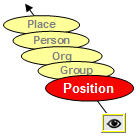Positions, jobs, can stand for, can represent, all the other key node types: people hold positions, which gives them a physical place; manager positions represent organizations and groups |
|
|
When we map the network of positions, we are also bringing along all the other types of nodes that are part of a full model of organization. They are the “hidden” node mode types hiding “behind” the position node
|
|

